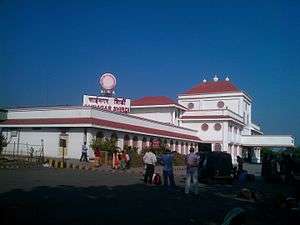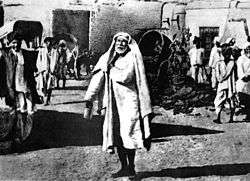Shirdi
- Not to be confused with Shiradi
| Shirdi शिर्डी साईनगर | |
|---|---|
| town | |
|
| |
 Shirdi | |
| Coordinates: 19°46′N 74°29′E / 19.77°N 74.48°ECoordinates: 19°46′N 74°29′E / 19.77°N 74.48°E | |
| Country |
|
| State | Maharashtra |
| District | Ahmednagar |
| Elevation | 504 m (1,654 ft) |
| Population (2011) | |
| • Total | 36,004 |
| Languages | |
| • Official | Marathi |
| Time zone | IST (UTC+5:30) |
| PIN | 423109 |
| Telephone code | 02423 |
| Vehicle registration | MH-17 |
| Website |
maharashtra |
Shirdi ![]() pronunciation (Marathi: शिर्डी) is a town and falls under the jurisdiction of municipal council popularly known as Shirdi Nagar Panchayat, located in Rahata Taluka (Sub-division) in Ahmednagar District in the Indian state of Maharashtra. It is accessible via the Ahmednagar - Manmad State Highway No.10, approximately 83 km from Ahmednagar and 15 km from Kopargaon. It is located 185 km east of the Western Seashore line (the Ahmednagar - Manmad road), which is a very busy route. Shirdi is best known as the late 19th century home of the popular guru Shirdi Sai Baba.[1] It is one of the richest temple organisations.
pronunciation (Marathi: शिर्डी) is a town and falls under the jurisdiction of municipal council popularly known as Shirdi Nagar Panchayat, located in Rahata Taluka (Sub-division) in Ahmednagar District in the Indian state of Maharashtra. It is accessible via the Ahmednagar - Manmad State Highway No.10, approximately 83 km from Ahmednagar and 15 km from Kopargaon. It is located 185 km east of the Western Seashore line (the Ahmednagar - Manmad road), which is a very busy route. Shirdi is best known as the late 19th century home of the popular guru Shirdi Sai Baba.[1] It is one of the richest temple organisations.
Etymology
As per Indologist Vishwanath Khaire, the name Shirdi is derived from Tamil Seeradi = Seer + Adi. (In Tamil script : சீரடி = சீர் + அடி). (In Devanagari script : सीर् + अडि = सीरडि). — The name in Tamil language means The Foot of Prosperity. [2] [3]
Demographics
As of the 2011 India census, the population of Shirdi stood at 36,004. Males constitute 53% of the population and females 47%. Shirdi has an average literacy rate of 70%, higher than the national average of 59.5%: male literacy is 76%, and female literacy is 62%. In Shirdi, 15% of the population is under 6 years of age.[4] But, Shirdi being a pilgrimage centre, also has a large floating population. On any given day some 25,000 devotees come for darshan. On holidays the number reaches about half a million people. Due to the easy availability of jobs, a large migrant population, mainly of unskilled labourers from Uttar Pradesh, Bihar, Chhattisgarh, Andhra Pradesh, and Telangana etc. also reside here.
Transportation

Shirdi is located approximately 296 km from Mumbai, capital of Maharashtra in India. It is called the Land of Sai. The closest and most highly connected city from Shirdi is Ahmednagar city.
Rail
Shirdi now has a new railway station called "Sainagar Shirdi", which became operational in March 2009.
As of 2011, there are trains from Chennai,[5][6] Mumbai, Visakhapatnam, Mysore[7] and other cities/states that have Shirdi railway station as their terminal stop.Trains also run from Manmad railway station which is 87 km and Ahmednagar railway station which is 83 km from the heart of Shirdi, alternatively from Kopargaon station which is 15 km from Shirdi, or Nashik city, which is 119 km from Shirdi or Nagarsol. Daund railway station is170 km from Shirdi.
Road
Buses and taxis ply from these railway stations and locations to and from Shirdi. Shirdi can be reached by bus from any of the following cities in Maharashtra State (India): Ahmednagar, Mumbai, Pune, Thane, Nashik, Akluj, Dhule, Nagpur and Aurangabad.Also from Hyderabad, Telangana from where maximum pilgrims reach every day and year to seek blessings from Sai Baba. Currently, four-laning of State highway Nagar-Manmad highway is in progress on BOT basis. Maharashtra State Road Development Corporation has been assigned to execute the works of internal roads in Shirdi.
Air
Shirdi Airport is being constructed at Kakdi (Kopargaon taluka), 14 km south-west of Shirdi. Originally operations were expected to start by December 2011,[8] but the construction according to the original plans was completed in February 2016, and the first trial flight landed on 2 March 2016.[9] There are plans to lengthen the runway from 2,200 metres to 3,200 metres.The target completion date is 2017 or 2018.[10]
References
- ↑ "Shirdi". Amazing Maharashtra.
- ↑ http://www.newindology.in/
- ↑ http://www.newindology.in/Docs/Place%20names%20in%20Maharashtra.pdf
- ↑ "Census of India 2001: Data from the 2001 Census, including cities, villages and towns (Provisional)". Census Commission of India. Archived from the original on 2004-06-16. Retrieved 2008-11-01.
- ↑ "New trains will start operations from July". The Hindu. 2011-06-30. Retrieved 27 April 2012.
- ↑ "Coimbatore-Tuticorin Express service from today". Tuticorin: The Hindu. 2011-07-01. Retrieved 27 April 2012.
- ↑ "Mysore-Shirdi weekly train from Aug 1". Hubli: The Times of India. 2011-07-29. Retrieved 27 April 2012.
- ↑ "Shirdi airport work in full swing: Official". Times of India. 2 July 2010. Retrieved 3 June 2012.
- ↑ Yogesh Naik (3 March 2016). "First trial flight touches down at Shirdi airport". Mumbai Mirror. Retrieved 5 April 2016.
- ↑ Kunal Anand (10 February 2016). "Maharashtra govt made the runway for Shirdi Airport in 2013, rest of it will be made in 2017!". India Times. Retrieved 5 April 2016.
External links
-
 Shirdi travel guide from Wikivoyage
Shirdi travel guide from Wikivoyage - Directions To Shirdi
- How to Reach Shirdi Town

